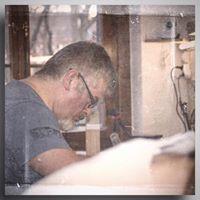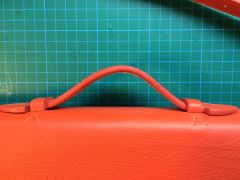-
Posts
49 -
Joined
-
Last visited
Content Type
Profiles
Forums
Events
Blogs
Gallery
Everything posted by malchik
-

What Is This Tool Called, And Where Do I Find It?
malchik replied to conceptdiba's topic in Leatherwork Conversation
I agree with you Trox, partially at least Giardini makes a very good paints (in cooperation with Stahl), I like best semi-dense which allows heat treatment as well. What kind of edge paint someone uses depends of style, and how is about to be applied. I'm using Vernis 600 for most of my products, used before Fenice, gave a try to Giardini dense and semi-dense. Fenice is not even close to Giardini og Vernis (neither requires heat treatment) and later penetrates leather better/deeper. As stated, I'm doing heat treatment because of melting the paint into the leather which gives a very neat and durable edge. Just to add to Trox instructions, lightly sanded edges before application (to even the edge and remove traces of glue) promotes better adhesion. My 5 cents If you just starting, go for Giardini, you cant miss Later on, you'll find what works best for you -
What to say, people gets obsessed what the big one uses (have been in this train as well) forgetting that the most important is how to use it. Thick paints are intended for use in edge machines and usually doesn't works well with electric creasers and hot edge treatment. Hermés uses a lot of machinery, also edge paint machines, so what Hermés uses it's a broad term. If you are doing edge finish by hand and your technique demands use of hot edging (i.e. edge durability) like in the case of Hermés bags, than you have to use edge paint with less viscosity enabling paint to penetrate deeper into the edge. By applying hot iron treatment, the layer of paint melts down producing strongest bond you can get (much stronger than with thick paint). Regarding how many layers you need for neat edge, I usually need 2 or 3 to make a perfect edge both with Tandy Professional Edge (Fenice), Giardini semi dense matt and Vernis 600. The trick is to make edge layers as even as possible, lightly sanded, before you apply the paint. Those three mentioned paints are pretty similar in the final result and in terms of durability. Giardini (cooperates with Stahl) and Fenice are by my opinion acrylics, but for vernis 600 I'm not sure, it doesn't appears as an acrylic. Real difference is temperature of hot iron required to melt down the paint (V600 requires higher)... So, morale of the story is don't get blinded what Big Names uses, find what works for you best
-
Hi Yin, sorry for late answer. The edge ink I'm using is Fenice one called section lacquer bought at Tandy, but it seems they don't sell it anymore. I got a tip that Giardini one is good as well and is not so pricy either. you can find more about on http://www.leatheredgepaint.com/portfolio/dense-leather-edge-paint/ and even order cheep trial pack to test if is it working for you. Both of edge paints can be treated thermally (hot-glazing), but please note you hot-glaze just a first layer.
-

What Is This Tool Called, And Where Do I Find It?
malchik replied to conceptdiba's topic in Leatherwork Conversation
For tips you can check http://www.ebay.com/itm/301284016005 I tested them, works fine with soldering iron accepting 4mm tips. I'm using Tandy (Fenice) professional edge paint (section lacquer) ant I'm happy with results (see some examples on https://www.facebook.com/kami.leathercraft). -
Thanks, I bought factory dyed so I can't tell. The color is bright orange and I know, I know, pictures should be better, those was taken at the midnight when I was finished with everything. Morning after I delivered the bag.
-
Painted, hot-glazed and polished with wax
-
Thanks 9tpi (it's actually Joseph Dickson 7tpi slimline ) I'm still learning
-
Thanks Yes actually it is, fits nice to purpose The bag is lined with vegtan goat skin, outside is milled cow hide. Here's some pictures from inside.
-
From the album: Orange satchel
-
Satchel for MacPro 13'. See my videos: Making a wallet: Making a watch strap:
-
From the album: Orange satchel
© KAMILeather
-

What Is This Tool Called, And Where Do I Find It?
malchik replied to conceptdiba's topic in Leatherwork Conversation
Thanks Mikesc, shall we use private messages to post our needs or? Personally I'm interested for both... -
Since I started with leatherworking I was confused by measurement of the linen thread. Even though I understand rationale behind certain measurement systems I found rather difficult to make comparisons between different measurements. I'm using mostly Fil Au Chinois but sometimes (when I don't have a time to wait for shipment from France) I'm using Campbells, Barbour, etc. Sometimes I just need thinner thread than Fil Au Chinois produces or the thickness I need for job that comes sporadically (French thin threads are blody expensive!) So, I made some table that compares two measurement systems with thickness in mm (aprox.) in parentheses. Babour | Fil au Chinois ------------------------------ 12/3 (1) 18/5 (0.9) 332 (0.77) 18/3 (0.6) 432 (0.63) 532 (0.57) 20/3 (0.52) 632 (0.51) 30/3 (0.45) 832 (0.43) 35/3 (0.4) 40/3 (0.37) 60/3 (0.30) If you have some other thoughts/info, please complete the list.
-

Mini Satchel Bag
malchik replied to malchik's topic in Purses, Wallets, Belts and Miscellaneous Pocket Items
Thank you Cynthia. I'm still learning and my teachers are YouTube, "The Leatherworking Handbook" from Valerie Michael and goddam lot of trial and error. Occasional visit to Hermés and Luis Vuitton shops helps keeping motivation high Wish I have someone, if not for tutoring, at least to ask from time to time for help (like "what I'm doing wrong with my saddle stitch).














